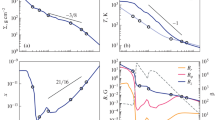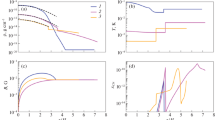Abstract
The theory of the fossil magnetic field of young stars and their accretion disks has been verified by comparing the observational data with the results of numerical simulations of the collapse of protostellar clouds. A new model of dust evaporation has been proposed, in which the parameter is not the thickness of the mantles, but the initial ratio of the core radius to the mantle radius of a dust grain. A semi-analytical description of the evolution of the radius distribution of dust grains was constructed. On its basis, the variations in the relative number density of dust grains, as well as the average values of the radius, cross-sectional area, and mass of dust grains, were calculated. It was shown that at the stage of disappearance of dust cores, these averages reach their maxima, but this does not affect the interaction of dust with gas particles, since the dust becomes scarce. Using cloud models W3 (main), NGC 2024, and DR 21 OH1, it has been demonstrated that neglecting dust evaporation underestimates the fossil magnetic field by several times. The possibility of formation of a magnetic compaction at the outer boundary of the zone of strong magnetic field diffusion (dead zone) has been confirmed. It is concluded that a correct calculation of dust evolution, ionization of the medium, and collapse anisotropy makes it possible to match the theoretical and observed magnetic fields of young stars and their accretion disks.








Similar content being viewed by others
REFERENCES
A. E. Dudorov and S. A. Khaibrakhmanov, in Stars: From Collapse to Collapse, Proceedings of a Conference, Nizhny Arkhyz, Russia, October 3–7, 2016, Ed. by Yu. Yu. Balega, D. O. Kudryavtsev, I. I. Romanyuk, and I. A. Yakunin (Astron. Soc. Pacif., San Francisco, 2017), p. 114.
J. Braithwaite and H. Spruit, R. Soc. Open Sci. 4, 160271 (2017).
A. S. Brun and M. K. Browning, Liv. Rev. Solar Phys. 14, 4 (2017).
B. B. Karak, M. Rheinhardt, A. Brandenburg, P. J. Kapyla, and M. J. Kapyla, Astrophys. J. 795, 16 (2014).
A. S. Jermyn and M. Cantiello, Astrophys. J. 900, 113 (2020).
D. Moss, Astron. Astrophys. 414, 1065 (2004).
N. A. Featherstone, M. K. Browning, A. S. Brun, and J. Toomre, Astrophys. J. 705, 1000 (2009).
D. A. Frank-Kamenetskii, Lectures on Plasma Physics (Atomizdat, Moscow, 1968) [in Russian].
L. E. Cram, Astrophys. J. 234, 949 (1979).
R. M. Crutcher, Astrophys. J. 520, 706 (1999).
A. E. Dudorov, S. A. Khaibrakhmanov, and A. M. Sobolev, Mon. Not. R. Astron. Soc. 487, 5388 (2019).
A. F. Kholtygin, O. A. Tsiopa, E. I. Makarenko, and I. M. Tumanova, Astrophys. Bull. 74, 293 (2019).
F. Villebrun, E. Alecian, G. Hussain, J. Bouvier, et al., Astron. Astrophys. 622, A72 (2019).
C. M. Johns-Krull, Astrophys. J. 664, 975 (2007).
J.-F. Donati, F. Paletou, J. Bouvier, and J. Ferreira, Nature (London, U.K.) 438, 466 (2005).
J. F. J. Bryson, B. P. Weiss, J. B. Biersteker, A. J. King, and S. S. Russell, Astrophys. J. 896, 103 (2020).
W. H. T. Vlemmings, B. Lankhaar, P. Cazzoletti, C. Ceccobello, et al., Astron. Astrophys. 624, L7 (2019).
R. E. Harrison, L. W. Looney, I. W. Stephens, Z.-Y. Li, et al., Astrophys. J. 908, 141 (2021).
S. M. Houghton and P. J. Bushby, Mon. Not. R. Astron. Soc. 412, 555 (2011).
Y. Kawasaki, S. Koga, and M. N. Machida, Mon. Not. R. Astron. Soc. 504, 5588 (2021).
M. R. Bate, T. S. Tricco, and D. J. Price, Mon. Not. R. Astron. Soc. 437, 77 (2014).
A. Bhandare, R. Kuiper, T. Henning, C. Fendt, M. Flock, and G.-D. Marleau, Astron. Astrophys. 638, A86 (2020).
G. Wuchterl and W. M. Tscharnuter, Astron. Astrophys. 398, 1081 (2003).
G. A. Feiden and B. Chaboyer, Astrophys. J. 761, 30 (2012).
A. Hujeirat, P. Myers, M. Camenzind, and A. Burkert, New Astron. 4, 601 (2000).
S. N. Zamozdra, Cand. Sci. (Phys. Math.) Dissertation (Chelyabinsk, 2010).
R. Mignon-Risse, M. Gonzalez, B. Commercon, and J. Rosdahl, Astron. Astrophys. 652, A69 (2021).
A. E. Dudorov and Yu. V. Sazonov, Nauch. Inform. Astron. Sov. AN SSSR 63, 68 (1987).
M. W. Kunz and T. C. Mouschovias, Mon. Not. R. Astron. Soc. 408, 322 (2010).
Y. Tsukamoto, K. Iwasaki, S. Okuzumi, M. N. Machida, and S. Inutsuka, Mon. Not. R. Astron. Soc. 452, 278 (2015).
J. Wurster, M. R. Bate, and D. J. Price, Mon. Not. R. Astron. Soc. 481, 2450 (2018).
N. Vaytet, B. Commercon, J. Masson, M. Gonzalez, and G. Chabrier, Astron. Astrophys. 615, A5 (2018).
G. Morfill, S. Roeser, H. Voelk, and W. Tscharnuter, Moon Planets 19, 211 (1978).
V. Guillet, P. Hennebelle, G. P. des Forets, A. Marcowith, B. Commercon, and P. Marchand, Astron. Astrophys. 643, A17 (2020).
P. Lenzuni, H.-P. Gail, and T. Henning, Astrophys. J. 447, 848 (1995).
W. J. Duschl, H.-P. Gail, and W. M. Tscharnuter, Astron. Astrophys. 312, 624 (1996).
S. N. Zamozdra and A. G. Zhilkin, Astron. Astrophys. Trans. 27, 517 (2012).
P. Marchand, J. Masson, G. Chabrier, P. Hennebelle, B. Commercon, and N. Vaytet, Astron. Astrophys. 592, A18 (2016).
I. Bauer, F. Finocchi, W. J. Duschl, H.-P. Gail, and J. P. Schloder, Astron. Astrophys. 317, 273 (1997).
K. Lodders, Space Sci. Rev. 217, 44 (2021).
K. M. Pontoppidan, C. Salyk, E. A. Bergin, S. Brittain, B. Marty, O. Mousis, and K. I. Oberg, in Protostars and Planets VI (Univ. Arizona Press, 2014), p. 363. https://hal.archives-ouvertes.fr/hal-01346297 .
Ya. N. Pavlyuchenkov, A. G. Zhilkin, E. I. Vorobyov, and A. M. Fateeva, Astron. Rep. 59, 133 (2015).
H. W. Yorke, Astron. Astrophys. 80, 308 (1979).
Y. V. Skorov, L. Rezac, P. Hartogh, and H. U. Keller, Astron. Astrophys. 600, A142 (2017).
F. P. Fanale and J. R. Salvail, Icarus 60, 476 (1984).
T. Nakano, R. Nishi, and T. Umebayashi, Astrophys. J. 573, 199 (2002).
L. Spitzer, Physical Processes in the Interstellar Medium (Wiley, New York, 1978).
I. S. Grigor’ev and E. Z. Meilikhov, Handbook of Physical Quantities (Energoatomizdat, Moscow, 1991; CRC, Boca Raton, NY, 1996).
A. E. Dudorov and Yu. V. Sazonov, Nauch. Inform. Astron. Sov. AN SSSR 49, 114 (1981).
H. Masunaga and S. Inutsuka, Astrophys. J. 531, 350 (2000).
J. B. Pollack, D. Hollenbach, S. Beckwith, D. P. Simonelli, T. Roush, and W. Fong, Astrophys. J. 421, 615 (1994).
V. I. Shematovich, D. S. Wiebe, B. M. Shustov, and Z.‑Y. Li, Astrophys. J. 588, 894 (2003).
B. Zhao, P. Caselli, and Z.-Y. Li, Mon. Not. R. Astron. Soc. 478, 2723 (2018).
W. R. Webber, Astrophys. J. 506, 329 (1998).
F. Finocchi and H.-P. Gail, Astron. Astrophys. 327, 825 (1997).
M. W. Kunz and T. C. Mouschovias, Astrophys. J. 693, 1895 (2009).
D. McElroy, C. Walsh, A. J. Markwick, M. A. Cordiner, K. Smith, and T. J. Millar, Astron. Astrophys. 550, A36 (2013).
Ya. B. Zel’dovich and Yu. P. Raizer, Physics of Shock Waves and High-Temperature Hydrodynamic Phenomena (Nauka, Moscow, 1966; Academic Press, New York, 1966, 1967).
C. W. Allen, Astrophysical Quantities (Athlone Press, London, 1973).
C.-C. Yang, M.-M. Mac Low, and A. Johansen, Astrophys. J. 868, 27 (2018).
W. Lyra, A. Johansen, A. Zsom, H. Klahr, and N. Piskunov, Astron. Astrophys. 497, 869 (2009).
K. Tassis and T. C. Mouschovias, Astrophys. J. 618, 783 (2005).
D. Semenov and D. Wiebe, Astrophys. J. Suppl. 196, 25 (2011).
R. J. Tayler, Mon. Not. R. Astron. Soc. 227, 553 (1987).
A. E. Dudorov, Astron. Rep. 39, 790 (1995).
C. P. Folsom, P. Petit, J. Bouvier, A. Lebre, et al., Mon. Not. R. Astron. Soc. 457, 580 (2016).
Funding
The dust evolution model (Section 2) was developed with the financial support of the Russian Science Foundation (project no. 19-72-10012). The effect of dust evaporation on the fossil magnetic field (Section 3) was investigated with the financial support of the Russian Foundation for Basic Research (project no. 20-42-740013-Ural).
Author information
Authors and Affiliations
Corresponding author
Ethics declarations
The authors declare that they have no conflicts of interest.
Additional information
Translated by M. Chubarova
Rights and permissions
About this article
Cite this article
Dudorov, A.E., Zamozdra, S.N. Effect of Dust Evaporation on the Fossil Magnetic Field of Young Stars and Their Accretion Disks. Astron. Rep. 66, 200–220 (2022). https://doi.org/10.1134/S1063772922040035
Received:
Revised:
Accepted:
Published:
Issue Date:
DOI: https://doi.org/10.1134/S1063772922040035




